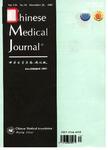Anti-tumor effects of polybutylcyanoacrylate nanoparticles of diallyl trisulfide on orthotopic transplantation tumor model of hepatocellular carcinoma in BALB/c nude mice
Anti-tumor effects of polybutylcyanoacrylate nanoparticles of diallyl trisulfide on orthotopic transplantation tumor model of hepatocellular carcinoma in BALB/c nude mice作者机构:Health Examination Center Qilu Hospital of Shandong University Jinan 250012 China Department of Health Care Qilu Hospital of Shandong University Jinan 250012 China Department of Pharmaceutics College of Pharmacy Shandong University Jinan 50012 China
出 版 物:《Chinese Medical Journal》 (中华医学杂志(英文版))
年 卷 期:2007年第120卷第15期
页 面:1336-1342页
核心收录:
学科分类:1002[医学-临床医学] 100214[医学-肿瘤学] 10[医学]
基 金:a fund of the Natural Science Foundation of Shandong(No.Y2004C34)
主 题:hepatocellular polybutylcyanoacrylate nanoparticles model animal orthotopic transplantation
摘 要:Background Hepatocellular carcinoma (HCC) ranked the second among the causes of cancer mortality in China since the 1990s. Up to now, medication still plays an important role in the treatment of HCC. The therapies based on the allicin as a potential chemopreventive analog although is in its infancy at the present time, may have a significant role in the future management of HCC. Diallyl trisulfide (DATS) is a natural compound derived from garlic. In this study, we investigated the inhibitory effects of hepatic targeted polybutylcyanoacrylate nanoparticles of diallyl trisulfide (DATS-PBCA-NP) on orthotopic transplanted HepG2 hepatocellular carcinoma in nude mice. Methods DATS-PBCA-NP were detected by transmission electron microscope (TEM) and high-performance liquid chromatography (HPLC). The orthotopic transplantation HCC models were established by implanting HCC HepG2 xenograft bits under the envelope of the mice liver. Successful models (n=29) were divided into 4 groups: normal saline (NS), empty nanoparticles (EN), DATS and DATS-PBCA-NP were intravenously administered to the mice respectively for 2 weeks. In vivo antitumor efficacy was evaluated by the measurement of tumor volume. Terminal deoxynucleotidyl transferase mediated dUTP nick end labeling (TUNEL) assay and protein levels of apoptosis and cell proliferation proteins by immunoblotting in tumor tissues were performed to elucidate the possible mechanism. Results DATS-PBCA-NP possessed smooth and round appearance, dispersed well, and released in vitro in accord with double phase kinetics model. DATS-PBCA-NP changed the tissue/organ distribution of DATS in vivo. The successful rate of tumor implantation was 100%. Intravenous administration of DATS-PBCA-NP significantly retarded the growth of orthotopically transplanted hepatoma in BALB/c nude mice (compared with the other three groups, all P〈0.05) without causing weight loss (P〉0.05). TUNEL staining showed that the tumors from DATS-PBCA-NP treated mice e



